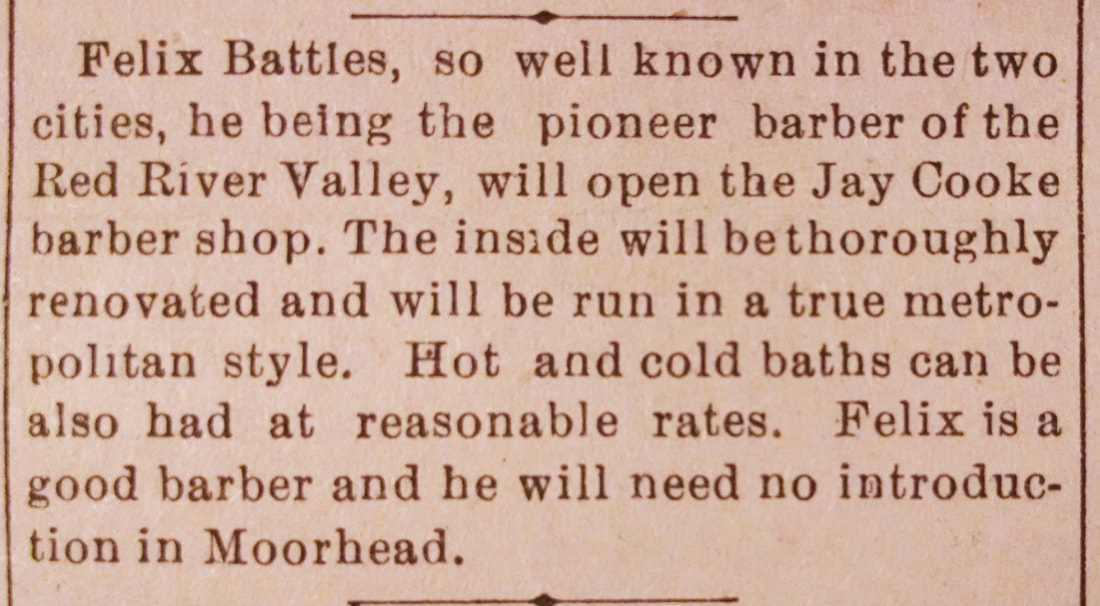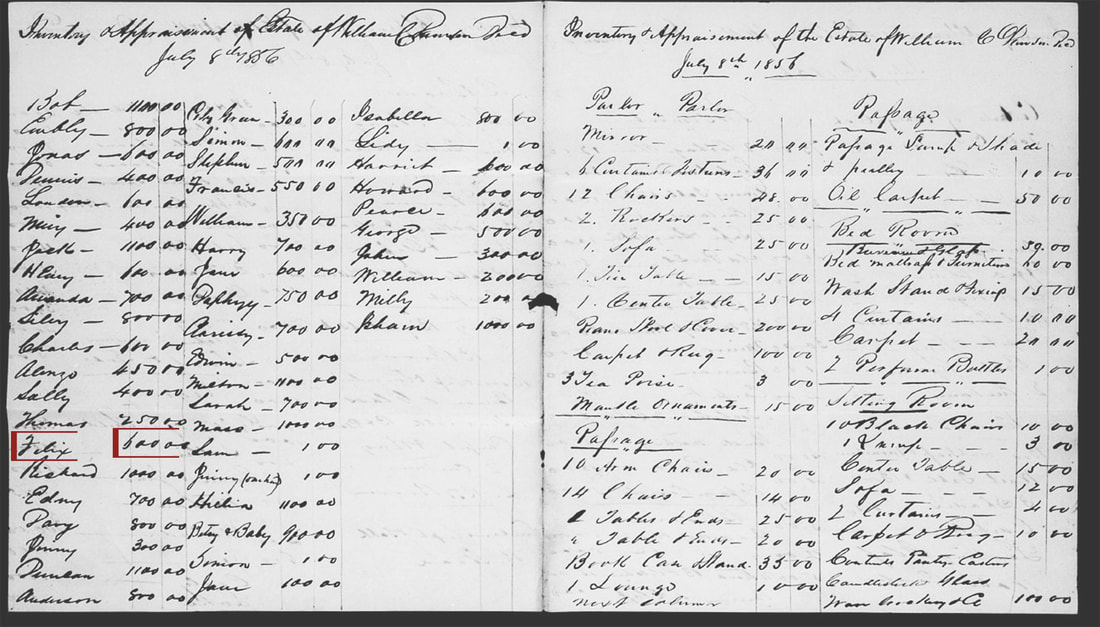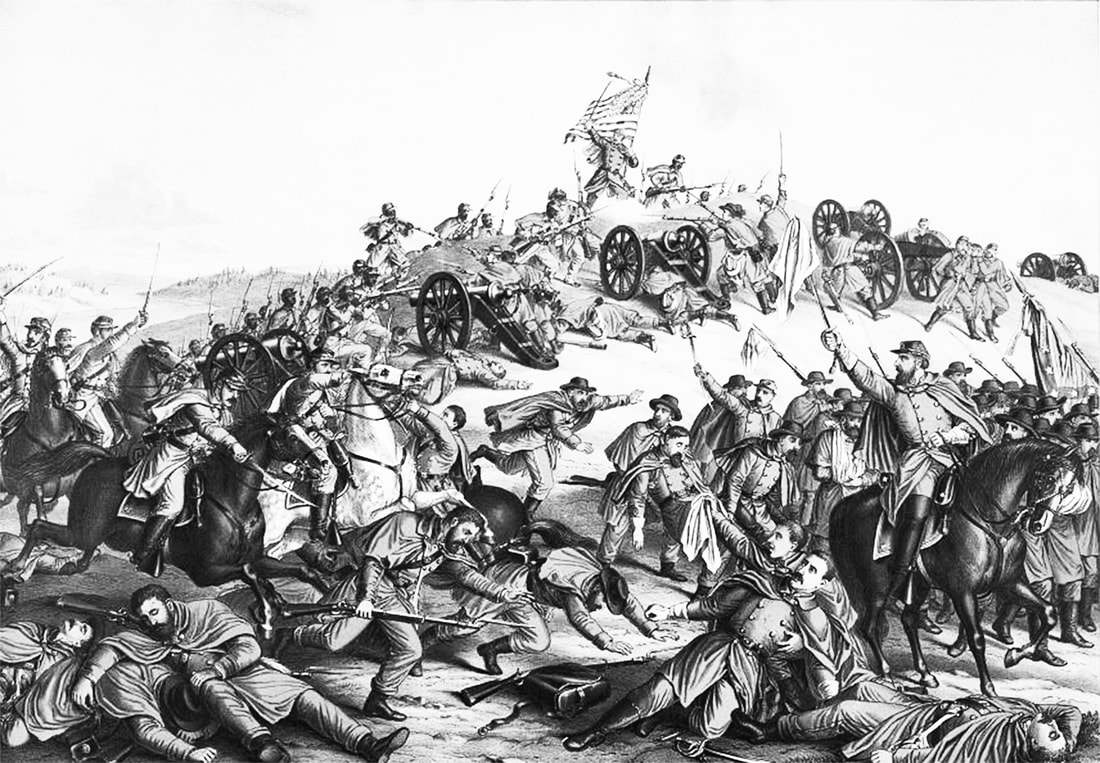Who is Felix Battles?
Felix Battles was called "the pioneer barber of the Red River Valley." He arrived in Moorhead shortly after the city was founded in the 1870s and lived here until he died in 1907. Battles was born into slavery in the early 1840s on a cotton plantation near Memphis, TN, and lived his childhood enslaved near Holly Springs, MS.
Sometime between 1856-1860, Felix gained his freedom. He likely escaped his enslavers, but the story has been lost to history. He is listed in the 1860 census in Dubuque, Iowa, with three people who share his last name – perhaps his mother and two brothers? An aunt and two cousins? For some time he worked steamboats on the Mississippi in St. Paul. On August 8, 1864, he became one of more than 100 African Americans to join the Union Army from Minnesota. He served with the 18th United States Colored Infantry, and in November he was promoted to corporal. As a member of this regiment, he took part in the crucial Battle of Nashville, a Union victory that brought Battles back to his home state of Tennessee and effectively took the Confederate Army out of the western theater of the Civil War.
After the war, Battles worked on the Northern Pacific Railroad that brought him to the Red River Valley. He then worked as a traveling barber before setting up his own shop in Moorhead. A stroke forced him into retirement in 1905. He lived in south Moorhead with his wife Kate, her family, and their two children, Julia and Richard.
Why build a monument?
As our nation debates how the Civil War will be remembered in our schools, textbooks, and public spaces, we believe that Felix Battles embodied both a national Civil War hero and an integral part of our local history. We also think his story should be told loudly and clearly. Throughout our national history, stories like Felix's have been intentionally and systematically overlooked or erased. Our difficulties researching his life affirm this: no birth certificate, no photographs, no personal artifacts. His first public record? An anonymous listing in an 1850 slave schedule in Shelby County, Tennessee. His next? A name, Felix, in an 1856 Mississippi probate inventory. One of 68 enslaved men, women, and children. A 13-yr-old valued at $600.
A monument in Felix's memory promotes a greater interest in his story and others like it. A monument also stands to remind our future generations that many forgotten heroes — particularly among people of color — have made great sacrifices for this community. Felix can be admired for overcoming a lifetime of injustice and adversity, and he can be remembered for his bravery. After escaping slavery, he risked his life as an American soldier to free his fellow Americans and preserve the Union. After the war, he moved north to the frontier, married, raised a family, and built both a home and a business.
In short, we believe Felix Battles is a man Moorhead can be proud of.
Who were the U.S. Colored Troops?
"Arms in the hands of slaves had been the nightmare of Southern whites for generations. In 1863, the nightmare came true. It achieved a new dignity, self-respect, and militancy for the former slaves who fought for the Union. It helped them achieve equal citizenship and equal rights – for a time – after the war." - James McPherson, Historian
On January 1, 1863, President Lincoln's executive order known as the Emancipation Proclamation went into effect. Remembered mostly for freeing all enslaved people in the rebelling states, the proclamation also called for the active recruitment of black soldiers. Although some states like South Carolina, Louisiana, Kansas, and Massachusetts formed early regiments as state militia, black units came to be federalized as the United States Colored Troops (USCT).
Eventually 209,145 black American men served in the United States military during the Civil War, accounting for more than 10% of the Union Army and more than 25% of the Union's Navy. Most often, these servicemen were born enslaved, freed themselves by escaping to Union lines, and joined the army to fight for their fellow citizens in bondage. Through their bravery they overcame otherwise insurmountable obstacles; the war would not have been won without them.
After the war, many USCT soldiers returned home to rebuild and remake the south as a free land. The US government protected the new rights of black Americans in the era known as Reconstruction (1865-1877). USCT veterans often became leaders of the newly enfranchised Black communities and several USCT veterans were even elected to state legislatures. When Reconstruction ended in 1877, white supremacists regained control of southern governments and cultures through violence. Rights were taken, votes were suppressed, lynching and incarceration skyrocketed, and the USCT's crucial efforts in winning the war were purposely overlooked and concealed while Confederates were commemorated.
How can you help?
The Felix Battles Monument Committee composed of Fargo-Moorhead area Black community leaders is steering this project with the help of other volunteers, the Historical and Cultural Society of Clay County, and Minnesota State University Moorhead. We need to raise $3,000 more in order to pay for all the expenses. Felix Battles’ old home stood next to the Paseka School of Business at Minnesota State University Moorhead – the perfect place for a statue of a pioneer Black businessman. The statue has now been installed. Next spring, we plan to put up three interpretive panels to tell Felix's story.
If you would like to take part in those efforts, stop by the Hjemkomst Center to make a donation or donate online here.
Visit Us
|
Resources
|
|



